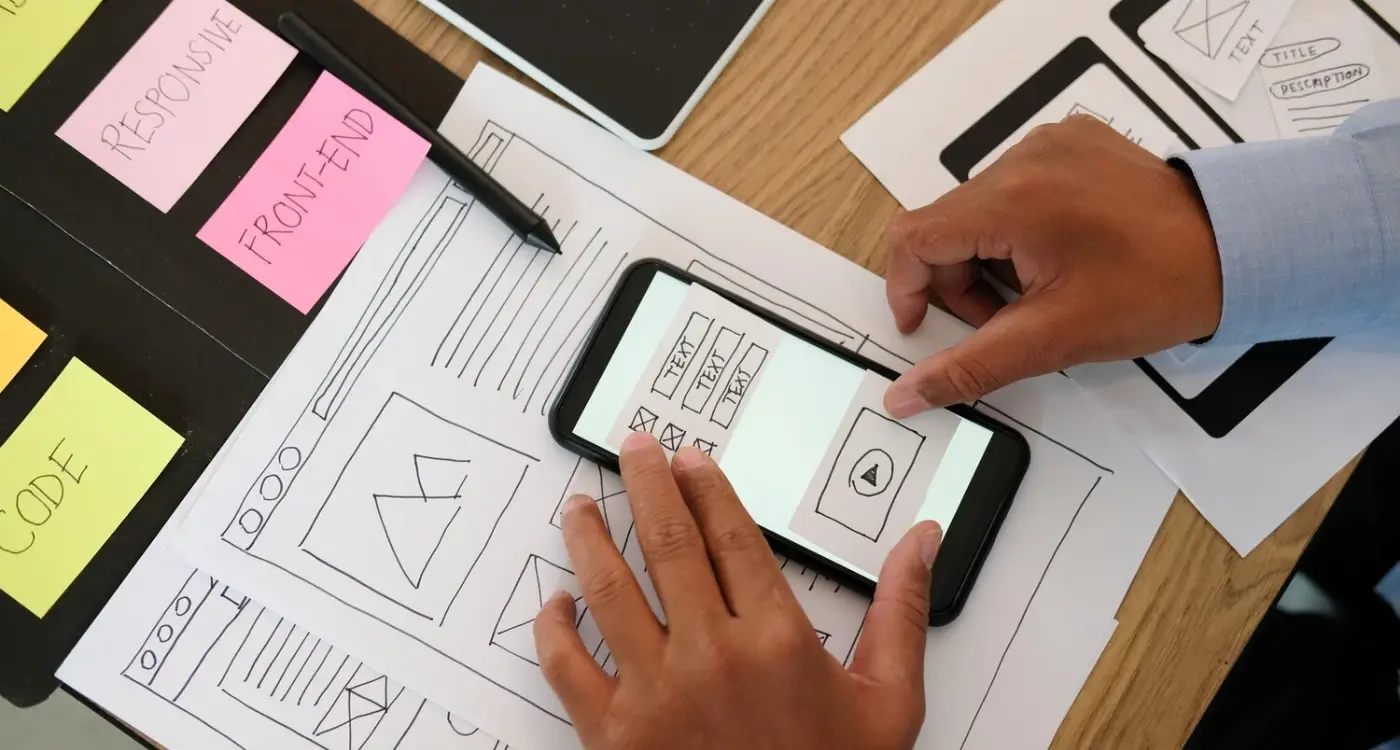How Do You Validate Your App Idea Before Development?
Nine out of ten mobile apps fail within their first year of launch. That's a staggering statistic that should make any entrepreneur pause before rushing into development. The graveyard of failed apps is littered with brilliant ideas that never found their audience, solid concepts that couldn't generate revenue, and innovative solutions that nobody actually wanted to use.
The harsh reality is that having a great app idea isn't enough anymore. The app stores are saturated with millions of options, and users have become incredibly selective about what they download and keep on their devices. This is where app idea validation becomes your lifeline—it's the process of testing and verifying your concept before you spend months and thousands of pounds building something that might never succeed.
Validation isn't about proving you're right; it's about discovering what's actually needed before it's too late to change course
Throughout this guide, we'll walk you through the complete validation process, from market research and user testing to technical feasibility and business model assessment. You'll learn how to gather real data, test your assumptions, and make informed decisions that dramatically increase your chances of building an app that people actually want to use and pay for.
Understanding Why Validation Matters
I've watched countless app ideas crash and burn over the years—and trust me, it's not pretty. The biggest mistake I see people make is jumping straight into development without checking if anyone actually wants their app. It's like opening a restaurant without knowing if people in your area even like that type of food.
App validation is simply testing your idea before you spend months building it. Think of it as a safety net that saves you time, money, and heartache. When you validate properly, you're finding out if real people have the problem you're trying to solve and whether they'd use your solution.
The Cost of Skipping Validation
Building an app without validation is expensive gambling. Development costs can easily reach tens of thousands of pounds, and that's before you factor in your time and stress. I've seen brilliant developers pour months into apps that nobody downloads because they never checked if there was demand.
The app stores are graveyards of unvalidated ideas. Apps that seemed brilliant in someone's head but solved problems that didn't exist or weren't painful enough for people to care about fixing. Understanding what are the main reasons mobile apps fail can help you avoid these common pitfalls.
What Validation Actually Tells You
Proper validation gives you concrete answers about your idea's viability:
- Whether people actually face the problem you're solving
- How urgently they need a solution
- What features matter most to them
- How much they'd pay for your app
- Who your real competitors are
Validation isn't about proving you're right—it's about discovering what's actually true about your market before you commit serious resources to development.
Researching Your Market and Competition
Right, let's talk about something that'll save you from making a very expensive mistake—properly researching your market and competition. I've seen too many brilliant app ideas fail because their creators skipped this step, thinking they already knew everything about their target audience. Spoiler alert: they didn't!
Market research isn't just about proving your app idea is good; it's about understanding who will actually use it and why. Start by identifying your target users—not just their age and location, but their problems, habits, and what they're currently doing to solve the issues your app addresses. Use surveys, interviews, and online forums to gather real insights from real people.
Understanding Your Competition
Now for the fun part—spying on your competitors! Download every similar app you can find and use them properly. Don't just glance at screenshots; actually go through the user journey. What works well? What frustrates users in their reviews? This competitive analysis will help you spot gaps in the market and opportunities to do things better.
- Analyse competitor app store reviews and ratings
- Study their pricing models and user acquisition strategies
- Identify what features users consistently request
- Look for common complaints across multiple apps
Create a simple spreadsheet comparing your top 5 competitors' features, pricing, and user ratings. This visual comparison will help you identify where your app can stand out.
Remember, finding competitors isn't bad news—it proves there's demand for your type of app. The key is understanding how you'll be different and better.
Testing Your Concept with Real Users
Right, so you've done your research and you think you've got a solid app idea—now comes the really interesting bit. You need to test it with actual people, not just your mum or your best mate (though they might be lovely, they're probably not your target audience). This is where things get real and where you'll learn whether your brilliant idea is actually brilliant or just something that seemed good at 2am.
The beauty of testing early is that it's relatively cheap and quick. You don't need a fully working app; you can start with mockups, wireframes, or even just sketches on paper. I've seen people validate their app idea without writing a single line of code. What you're looking for is genuine feedback about whether people understand what you're trying to do and whether they'd actually use it.
Getting Started with User Testing
Start small—find five to ten people who fit your target audience and show them your concept. Ask them to talk through what they think it does, what problems it solves, and whether they can see themselves using it. Don't lead them or explain too much; just listen. Their confusion is valuable information, not a personal attack on your idea.
What to Look For
Pay attention to their immediate reactions and the questions they ask. If everyone's confused about the same thing, that's a red flag. If they start suggesting features you hadn't thought of, that's gold. The goal isn't to get everyone to love your idea—it's to understand whether you're solving a real problem in a way that makes sense to real people.
Assessing Technical Feasibility and Resources
Right, let's talk about the elephant in the room—can you actually build this thing? I've seen brilliant app ideas crash and burn because nobody asked the simple question: is this technically possible with our budget and timeline? It's one of those reality checks that separates dreamers from doers.
Start by listing out every feature your app needs. Not the nice-to-haves, but the absolute must-haves for your minimum viable product. Then research what technologies you'll need—does it require complex AI, real-time data processing, or integration with third-party services? Some features that sound simple can be surprisingly complex to implement.
Budget and Timeline Reality Check
Next, get realistic about your resources. Do you have developers on your team, or will you need to hire them? Are you looking at a few thousand pounds or tens of thousands? Understanding which criteria determine if your app idea is technically and financially feasible will help you make informed decisions about your project.
The most successful app ideas are often the ones that solve complex problems with surprisingly simple solutions
Consider building a basic prototype first—even a simple clickable mockup can help you understand the technical challenges ahead. If you're feeling overwhelmed by the technical side, that's completely normal. This is where talking to experienced developers becomes invaluable for proper concept validation.
Evaluating Business Model and Revenue Potential
Right, let's talk money—because at the end of the day, your app needs to pay for itself and hopefully much more. I've worked with countless clients who had brilliant ideas but hadn't thought through how they'd actually make money from them. Trust me, this conversation needs to happen before you write a single line of code.
Your business model is basically how you plan to turn users into revenue. Will you charge upfront for downloads? Use a subscription model? Rely on advertising? Sell premium features? Each approach has its pros and cons, and what works for one app might be completely wrong for another.
Common Revenue Models to Consider
- Freemium—free app with paid upgrades
- Subscription—monthly or yearly recurring payments
- One-time purchase—users pay once to download
- In-app purchases—buying virtual goods or features
- Advertising—showing ads to generate income
- Commission—taking a cut from transactions
The key is matching your revenue model to your target audience and app type. Gaming apps often do well with in-app purchases, whilst productivity apps might suit subscriptions better. Look at your competitors—what are they doing? More importantly, what aren't they doing that you could do better?
Don't forget to crunch the numbers. How many users do you need to break even? What's your projected lifetime value per user? These aren't just nice-to-have figures—they're the foundation of whether your app idea is actually viable.
Measuring Market Demand and User Interest
Right, so you've tested your concept with real users and you're feeling pretty good about the feedback. But here's the thing—getting people to say they like your idea is one thing; getting them to actually want it enough to download and use it is another beast entirely. This is where measuring genuine market demand comes in, and trust me, it's not as straightforward as you might think.
The trick is to look beyond the polite "oh that sounds interesting" responses and find real indicators of demand. You want to see if people are willing to invest something—their time, their email address, or even their money—in your app idea before it exists.
Testing Real Interest
One approach I love is creating a simple landing page that explains your app and asks people to sign up for updates. But don't just count email addresses; track how people found your page and what they do after they arrive. Are they sharing it? Are they asking questions? These behaviours tell you more than signup numbers alone.
Set up a simple survey asking potential users to rank features by importance and willingness to pay. This gives you concrete data about what matters most to your target market.
Measuring Methods
Here are some practical ways to gauge real market demand:
- Pre-launch email campaigns with conversion tracking
- Social media engagement analysis on posted concepts
- Google Ads testing with keyword research data
- Beta testing waitlists with referral tracking
- Competitor app review analysis for unmet needs
The key is looking for patterns across multiple measurement methods rather than relying on just one source of data for your market research.
Making Data-Driven Decisions About Development
Right, so you've done your research, tested with users, and gathered loads of data about your app idea. Now comes the moment where you need to make sense of it all and decide whether to move forward. This isn't about gut feelings anymore—it's about letting the numbers tell you what to do.
I always tell clients that this stage feels a bit like being a detective. You've got all these clues scattered around, and now you need to piece them together to solve the mystery of whether your app will succeed. Look at your user feedback first; if people aren't excited about your concept during testing, they won't be excited when it launches.
Key Metrics to Review
- User engagement rates during prototype testing
- Market size and growth potential
- Competition analysis results
- Technical complexity versus budget constraints
- Revenue projections and break-even timeline
Here's what I've learned over the years: if more than two major red flags appear in your data, it's probably time to pivot or pause. Maybe your target market is too small, or the technical challenges are too expensive to solve. That's not failure—that's smart business.
Once you've made the decision to move forward, you might want to consider building an MVP for your mobile app idea as the next logical step. The best app ideas have clear, positive signals across most areas. When the data aligns and tells a consistent story, that's when you know you're onto something worth building.
Conclusion
App idea validation isn't just a box to tick—it's the difference between building something people actually want and creating an expensive digital paperweight. I've watched too many brilliant developers pour months of work into apps that nobody downloads, and it's heartbreaking every single time.
The process we've covered gives you a proper roadmap: market research tells you if there's space for your idea, user testing shows you what people really think, and technical feasibility keeps you grounded in reality. None of these steps are glamorous, but they're what separate successful apps from the millions gathering dust in app stores.
What strikes me most about startup validation is how it changes your entire approach to development. Instead of guessing what users want, you're building with actual data. Instead of hoping for the best, you're making informed decisions about where to invest your time and money.
The hardest part? Sometimes validation tells you to pivot or even abandon your original idea entirely. But that's not failure—that's smart business. Better to discover these issues during concept validation than after you've spent thousands on development. Your future self will thank you for doing the groundwork now.
Share this
Subscribe To Our Learning Centre
You May Also Like
These Related Guides

How Do You Test Your App Idea Without Building Anything?

How Do I Know If My App Idea Will Actually Make Money?



